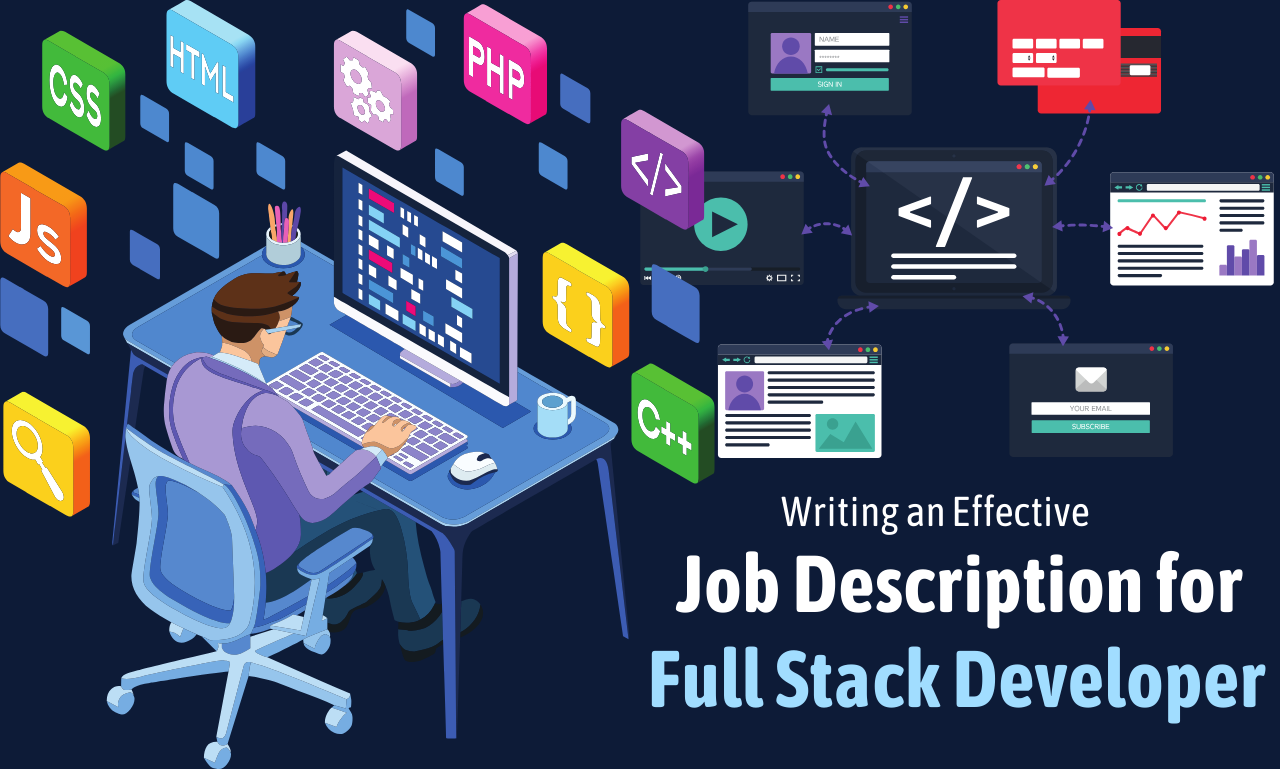In the fast-evolving tech landscape, finding the right full-stack developer can be challenging. A well-crafted job description not only attracts skilled candidates but also sets the stage for a successful working relationship. In this guide, we’ll cover how to create a clear and compelling job description that appeals to top-tier talent and helps you find the right developer for your project. Creating this clarity in job descriptions is as important as crafting a strong personal brand in freelancing, as explored in this guide on writing a powerful bio and introduction.
1. Understanding the Role of a Full Stack Developer
Define what a full-stack developer does, emphasizing their ability to handle both frontend and backend development. While full-stack developers are versatile, their role may vary depending on the project requirements.

Highlight the versatility of full-stack developers, noting that they:
- Build both client- and server-side applications.
- Handle architecture from the ground up.
- Bridge the gap between design and functionality.
2. Key Components of a Full Stack Developer Job Description
Each section of a job description serves a purpose in attracting qualified candidates:
- Job Title: Keep it clear and industry-standard, like “Full Stack Developer” or “Full Stack Engineer.”
- Role Overview: Provide a concise summary of the position and key responsibilities. For example, “As a Full Stack Developer, you’ll be responsible for designing, developing, and maintaining web applications to ensure smooth user experiences.”
3. Detailed Job Responsibilities
Break down the role’s responsibilities into specific, actionable tasks to give candidates a realistic picture of daily expectations:
- Develop and Maintain: Explain the importance of coding, maintaining, and testing the product.
- Collaboration: Describe interactions with team members, clients, and stakeholders.
- Troubleshooting and Optimization: Mention the need for ongoing debugging and performance optimization.
- Research and Development: Highlight the role of continuous learning and adapting to new technologies.
“A job description that’s precise and specific leads to better outcomes.” – Sheryl Sandberg
Including specificity is beneficial not only in job descriptions but also in freelancing proposals, as covered in this guide on writing tailored proposals.
4. Defining Required Skills and Qualifications
Break down the skills into categories:
- Core Technical Skills:
- Frontend: Proficiency in HTML, CSS, JavaScript, and frameworks like React or Angular.
- Backend: Knowledge of server-side languages like Node.js, Python, or Ruby.
- Database Management: Experience with SQL and NoSQL databases.
- API Development: RESTful or GraphQL API experience.
- Desirable Skills:
- Familiarity with cloud services like AWS or Azure.
- Experience in CI/CD processes for faster deployment.
“Skill is the unified force of experience, intellect, and passion.” – John Ruskin
- Soft Skills:
- Communication, teamwork, and problem-solving abilities.
Building a robust skill set is crucial for candidates to stand out, as this article on enhancing your freelance profile discusses.
5. Specifying Experience Requirements
Define the level of experience required and whether specific domain knowledge or industry experience is necessary:
- Junior Developers: Outline entry-level tasks, such as working under senior developers and handling less complex tasks.
- Mid-Level Developers: Emphasize the need for some independence and handling tasks autonomously.
- Senior Developers: List responsibilities like leading projects, mentoring junior developers, and making architectural decisions.
Mention any preferred qualifications, like experience in specific industries (e.g., e-commerce or SaaS), which could be advantageous.
6. Company Culture and Work Environment
Discuss how your company supports growth, flexibility, and innovation. Define the work environment, such as remote options or hybrid work. Highlighting these aspects helps candidates assess if they’re a cultural fit.

7. Offering Transparent Salary and Benefits
Being transparent with salary and benefits builds trust and attracts qualified applicants. Include a range if possible and list any noteworthy perks such as:
- Competitive Salary: Indicate a general salary range.
- Health and Wellness: Health insurance, gym memberships, or wellness programs.
- Professional Development: Opportunities for training, certifications, and conference attendance.
- Work-Life Balance: Flexible hours, remote work options, and paid time off.
8. Structuring the Application Process
Detail the steps of the application process, which might include:
- Resume and Portfolio Submission: Request relevant work samples or a GitHub link.
- Screening Questions: Include questions that test problem-solving skills or technical knowledge.
- Technical Assessments: Mention if a coding test will be part of the process.
- Interviews: Outline the interview stages, including any technical or cultural fit rounds.
9. Tips for Making Your Job Description Stand Out
Wrap up the article with some actionable advice for making a job description that truly resonates:
- Use Clear Language: Avoid jargon and make requirements easy to understand.
- Highlight Growth Opportunities: Mention any career advancement opportunities.
- Encourage Applications from Diverse Backgrounds: Promote an inclusive hiring process to attract diverse talent.
Encourage readers to periodically review and update job descriptions to reflect changing team needs and industry trends.
Summarize the impact of a thoughtfully crafted job description, emphasizing how clarity, transparency, and specificity can help attract qualified and engaged candidates. A comprehensive job description reflects a well-organized, forward-thinking company ready to welcome skilled professionals.









